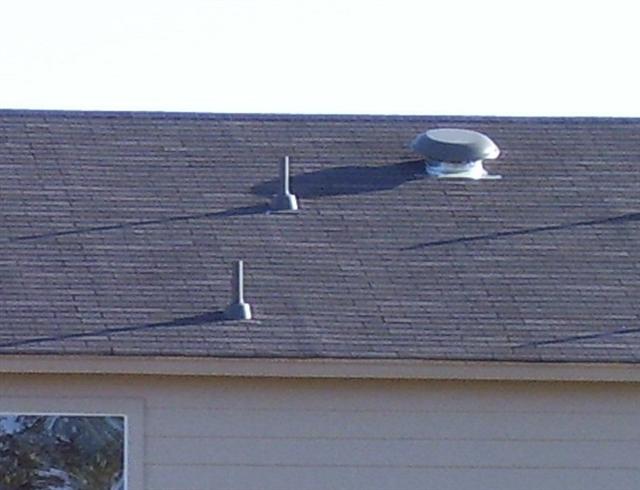New construction home - Asphalt shingles with vertical lines. Do you call the installation?
These appear to have been installed in rows from bottom of eave toward the ridge, instead of diagonal rows.
Thanks,

New construction home - Asphalt shingles with vertical lines. Do you call the installation?
These appear to have been installed in rows from bottom of eave toward the ridge, instead of diagonal rows.
Thanks,

do they overlap?
Racking method appears to be what you are showing in your pic. It’s a common practice by some roofers and an accepted technique when done correctly. As long as the ends don’t line up from course to course all should be well.
http://www.hometime.com/Howto/projects/roofing/roof_5.htm#racking
Well put
Racking shingles is a corner-cutter for roofers. In the end, on lighter colour shingles, the matching vertical lines stand out like hell and make the roof look bad. No where in shingle installation instructions have I seen manufacturers mention “racking” as a suggested method of installation.

When the spaces between shingles line up at every other row, it is called a home owner’s pattern. When they line up every 3rd row, it is called a carpenters pattern. When they line up every 7th row (this is what happens when you follow the instruction on the package), it is called a roofer’s pattern. A roofer told me that once.
It is in the written specs of several of the Architectural shingles.
I don’t do it that way, so I don’t have the specs from which manufacturer handy.
The biggest proble with the “Racking” method, besides the 3 foot and next 6" vertical pattern is, that many shoddy roofing installers, are doing it for better speed and less movement from the stair step method.
Often times, they do not lift up the tab on every second row, which is necessary to place the 4th nail in place.
This results in a 50 % total installation of “3 nailed” shingles, which ultimately could allow wind damage, not warranted from the manufacturers warranty.
Ed
Depends on the type of shingle. Here is an excerpt from the Owens Corning installation instructions for one of their shingles. Granted these are not the less expensive flat shingles but there are manufacturers that recommend the racking method for their archetectural shingles and some of their other types.
Course Application:
Vertical Racking Method. Apply shingles over properly prepared roof deck, starting at bottom of roof using the single-column, vertical-racking method. Owens Corning Berkshire shingles must be applied with a 4 3⁄4’’ offset
and 83⁄8’’ exposure. Caution must be exercised to ensure that end joints are no closer than 2’’ from a fastener in the shingle below. Refer to course application steps for specifi c instructions.
Note: Owens Corning Berkshire shingles ARE NOT to be installed
across and diagonally up the roof.
I stand corrected. I got out of roofing before architectural, laminated shingles became popular and my guys never installed any. I have seen mostly darker colours of these being installed in my area and that should possibly hide the effects that you see in my earlier picture. In very light colours, I can see that effect showing on the ends of even the laminated, arch style as they dry out, shrink and curl a bit on the abutting edges.
Have you ever seen the racking method recommended on the old 3-in-1 tab shingles?
Reminds me of some old hickory stripped bibs I have.
http://www.nachi.org/forum/attachment.php?attachmentid=15335&stc=1&thumb=1&d=1192847030
Racking for 3 tab shingles is for generally for speed, which is the idea when you are getting paid-by-the-square. If’s it new construction and the tabs aren’t well sealed down yet, I’d gently lift a few tabs and check for the missing blind nail. If that nail is missing in more than a few places, then I’d report that aspect of the installation. If they are gun nailed or stapled I’d be looking for low-nailing, which is generally any fastener below the line of cement spots, something else that can result from installing as fast as you can. More times than I can remember I’ve walked new roofs and observed literally dozens of shiny new nail-heads, not just an edge of the nailhead, I’m talking complete nail-heads! If the roof is walkable I always get on it if I can.
From “Professional Roofing” magazine, by Googling “Racked Asphalt Shingles”.
short excerpt:
Ed
Asphalt shingle performances varied greatly. Recently manufactured asphalt shingles (both three-tab and laminated) that appeared to meet current building codes seemed to perform well. However, blow-off of older, lightweight asphalt shingles that did not appear to meet current building codes was common. Also, the performance of asphalt shingles (regardless of age or style) installed by the racked method was noticeably worse than the performance of asphalt shingles installed using a conventional method. (For more information, see “The hurricanes of 2004,” September issue, page 22.)
Good stuff, Ed!
I agree thanks Ed much appreciated .
… Cookie
Thanks for all the good reference sites.!!
You are welcome.
I get a lot of links from you guys and gals too.
Ed
Personally, I wouldn’t hire a roofer who racked. I also would insist on high wind nailing (6 nails per shingle instead of 4) and finally I would only allow hand nailing. Most nail gun operators don’t have a clue about depth adjustment and just run along. Hand nailing works better and holds better.
I don’t like the way it looks, either. U-gly for sure.